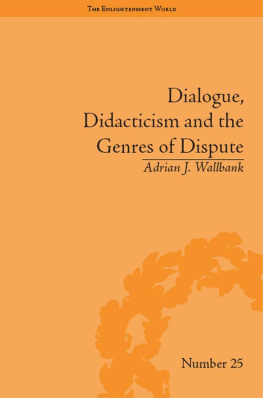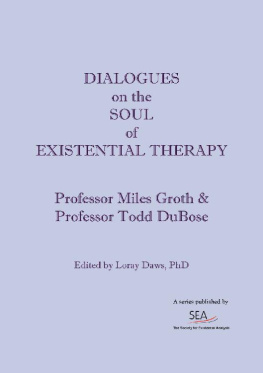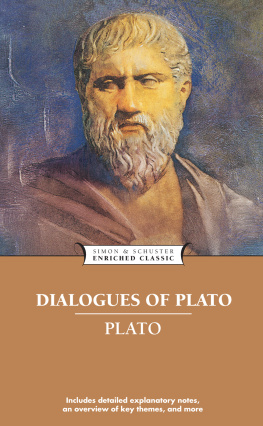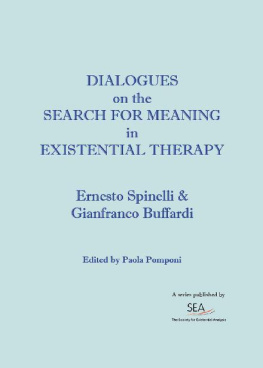DANIEL KOLAK, SERIES EDITOR
George Berkeley
Three Dialogues Between
Hylas and Philonous
EDITED BY MICHAEL B. MATHIAS
UNION COLLEGE
First published 2007 by Pearson Education, Inc.
Published 2016 by Routledge
2 Park Square, Milton Park, Abingdon, Oxon OX14 4RN
711 Third Avenue, New York, NY, 10017, USA
Routledge is an imprint of the Taylor & Francis Group, an informa business
Copyright 2007 Taylor & Francis
All rights reserved. No part of this book may be reprinted or reproduced or utilised in any form or by any electronic, mechanical, or other means, now known or hereafter invented, including photocopying and recording, or in any information storage or retrieval system, without permission in writing from the publishers.
Notice:
Product or corporate names may be trademarks or registered trademarks, and are used only for identification and explanation without intent to infringe.
Credits and acknowledgments borrowed from other sources and reproduced, with permission, in this textbook appear on appropriate page within text.
ISBN-13: 9780321276131 ( pbk)
Library of Congress Cataloging-in-Publication Data on file at the Library of Congress.
Contents

H aving surveyed the philosophical landscape at the dawn of the 18th century, George Berkeley (16851753) concluded that philosophers had become trapped in a maze of their own making. He believed that philosophers entered the maze by making a certain fundamental assumptionnamely, that matter exists. The leading metaphysical systems of his day, including those of Ren Descartes (15961650) and John Locke (16321704), described the physical world as a realm of objects or bodies composed of minute, insensible corpuscles of matter that exist independently of the human mind and are endowed only with scientific properties such as extension, mass, and mobility. According to this general worldview, which Berkeley referred to as materialism, the physical world as it really is exists independent of, and is radically different than, the physical world as it appears to our senses. According to materialism, a physical object, such as a teacup, is constituted of corpuscles of matter, which themselves have no color, odor, taste, or temperature. But a teacup certainly appears to have color on its surface, and the tea inside of it certainly appears to have a color, odor, taste, and temperature. This, according to the materialist, is simply because the corpuscles of matter that make up the teacup and the tea have the ability to affect our senses in certain ways in virtue of their extension, mass, and motion.
Materialism had acquired the status of orthodoxy by the early 18th century. But Berkeley feared that materialism would encourage skepticism and atheism, and, in turn, immorality. He also believed that this modern way of explaining things gives rise to intractableindeed, insolvableproblems in philosophy, science, mathematics, and theology. These problems, Berkeley thought, form the walls of a maze with no exit, and his fundamental philosophical project involved showing philosophers the way out of the maze by showing them how they had gotten into it in the first place. The only hope for philosophy, Berkeley believed, was to avoid entering the maze in the first placeto deny that matter exists.
Materialism had already been subjected to vigorous criticism by skeptical philosophers who argued that neither our senses nor reason provide sufficient justification for believing that matter exists. These skeptics concluded that we simply cannot know the true nature of the physical world, and, hence, we can only make guarded claims about how the world appears to be. One of the major preoccupations of the materialists in the 17th century, then, was combating this skepticism. Descartes and Locke invested considerable intellectual effort in constructing philosophical arguments to show that we have the capacity to know the material world for what it truly is. Though Berkeley believed that the materialists failed to meet the skeptics challenges, he was unwilling to resign himself to skepticism.
Berkeley realized that the materialists and skeptics shared a fundamental assumptionnamely, that the real world is distinct from the world we immediately experience with our five senses. Because they shared this assumption, Berkeley saw the materialists and skeptics as being trapped in the same maze. But where the skeptics rightly recognized that the maze is inescapable, the materialists wrongly believed that there is a way out of the maze. Berkeleys fundamental philosophical insight was that one can refuse to enter the maze in the first placethat is, one can deny that matter exists and, by doing so, deny that the real world is distinct from the world we directly perceive. By exposing these assumptions as false and even unintelligible, Berkeley intended to undermine materialism and skepticism at once. He aimed to show that we cannot even conceive of a material world existing independent of its being perceived, and, hence, the problems that arise from materialism, including the problem of skepticism, are not genuine philosophical problems at all. Rather, the materialists and skeptics were both struggling with what some recent philosophers have called pseudo-problemsproblems that cannot be solved because the very concepts involved in formulating them are nonsensical. When it is recognized that materialism rests upon incoherent assumptions, the walls of the maze that grow up around it simply dissolve.
Berkeleys analysis led him to develop a fantastic and revolutionary alternative to materialism. Central to his metaphysics is the claim that the whole of reality consists of the minds of spiritual beings and ideas in those minds. Berkeley referred to his view as immaterialism, by which he intended to convey that the fundamental constituents of reality are immaterialthat is, the minds of spiritual beings and the ideas in those minds are not composed of matter. Berkeleys view is also frequently referred to as idealism, which is intended to convey his view that ordinary physical objects exist only as collections of ideas in the minds of spiritual beings who perceive them. His view has often been summarized in the Latin slogan esse est percipi aut percipere (to be is to be perceived or to perceive). For a physical object, such as a teacup, to be is to be perceived, which means that the teacup exists only insofar as its constituent ideas are perceived. But if there are ideas that are perceived, there must also be minds that perceive them, and, for a mind, to be is to perceive.
Stated without context, Berkeleys worldview strikes many as absurd. It is perhaps all the more surprising to find that Berkeley styles himself as the defender of a vulgarthe term as Berkeley uses it means ordinary or everyday and does not have the pejorative connotation that it does todayconception of the world, and as an opponent to a convoluted, philosophical conception of the world. Where the philosophers believe that the real world is distinct from the world we immediately perceive, ordinary people believe that the real world just is the world that we directly or immediately perceive. Where the philosophers believe that the objects constituting the real world are distinct from
Next page













